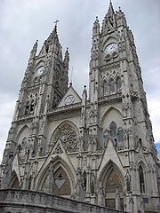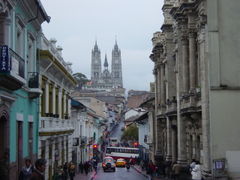
Basílica del Voto Nacional
Encyclopedia
The Basilica of the National Vow is a Roman Catholic
church located in the historic center of Quito, Ecuador. It is sometimes also called the Catedral Consagración de Jesús or the Basílica de San Juan. It is the largest neo-Gothic basilica in the Americas.
. President Luis Cordero issued the decree on July 23, 1883, and it was carried out by president José María Plácido Caamaño on March 5, 1884. The congress, in accordance with the year's budget, designated 12,000 pesos for the construction - 1,000 pesos per month, beginning in 1884. By the decree of July 3, 1885, the fourth Quitense Provincial Council turned the construction of the basilica into a religious commitment in the name of the country. In 1887, the Issodum Fathers began construction for five years, with the approval of Pope Leo XIII. The Oblato fathers donated the land for the basilica. To continue construction, donations were accepted from believers, who provided stones in exchange for engraving their names on them. In 1895, the state established a tax on salt to continue the building.
In 1901, Father Matovelle and his Community of Missionary Monks, took charge of the construction at the request of Archbishop Pedro Rafael González Calisto. The building was designed by architect Emilio Tarlier at the cost of 40,000 French francs. Tarlier was inspired by the Bourges Cathedral. On July 10, 1892, the first stone was placed. Between 1892 and 1909, the Heart of Mary Cathedral was constructed. The basilica was blessed by Pope John Paul II on January 30, 1985, and it was consecrated and inaugurated on July 12, 1988.
The basilica remains technically "unfinished." Local legend says that when the Basílica is completed, the end of the world will come.
 The basilica is the most important work of Neogothic Ecuadorian architecture and is one of the most representative of the Americas. It is the largest neogothic basilica in the New World. The building is noted for its grotesque
The basilica is the most important work of Neogothic Ecuadorian architecture and is one of the most representative of the Americas. It is the largest neogothic basilica in the New World. The building is noted for its grotesque
s in the form of native Ecuador
ian animals, such as armadillos, iguana, and Galapagos tortoises.
The Basilica is 140 meters long and 35 meters wide. It is 30 meters high in the sanctuary, 15 meters high in the votive chapels, 74 meters high in the transept, and 115 meters high in the two frontal towers. In the sanctuary, there are 14 bronze images representing 11 apostles and three evangelists. In the crypt, there is a pantheon containing the remains of several heads of state.
Visitors are able to see the sanctuary for free, while access to the rest of the Basilica ranges from $1–3. Visitors are able to climb to the top of the towers. From the highest point of the main tower, one can see the city and the surrounding mountains.
Roman Catholic Church
The Catholic Church, also known as the Roman Catholic Church, is the world's largest Christian church, with over a billion members. Led by the Pope, it defines its mission as spreading the gospel of Jesus Christ, administering the sacraments and exercising charity...
church located in the historic center of Quito, Ecuador. It is sometimes also called the Catedral Consagración de Jesús or the Basílica de San Juan. It is the largest neo-Gothic basilica in the Americas.
History
The basilica arose from the idea, proposed by father Julio Matovelle in 1883, of building a monument as a perpetual reminder of the consecration of Ecuador to the Sacred HeartSacred Heart
The Sacred Heart is one of the most famous religious devotions to Jesus' physical heart as the representation of His divine love for Humanity....
. President Luis Cordero issued the decree on July 23, 1883, and it was carried out by president José María Plácido Caamaño on March 5, 1884. The congress, in accordance with the year's budget, designated 12,000 pesos for the construction - 1,000 pesos per month, beginning in 1884. By the decree of July 3, 1885, the fourth Quitense Provincial Council turned the construction of the basilica into a religious commitment in the name of the country. In 1887, the Issodum Fathers began construction for five years, with the approval of Pope Leo XIII. The Oblato fathers donated the land for the basilica. To continue construction, donations were accepted from believers, who provided stones in exchange for engraving their names on them. In 1895, the state established a tax on salt to continue the building.
In 1901, Father Matovelle and his Community of Missionary Monks, took charge of the construction at the request of Archbishop Pedro Rafael González Calisto. The building was designed by architect Emilio Tarlier at the cost of 40,000 French francs. Tarlier was inspired by the Bourges Cathedral. On July 10, 1892, the first stone was placed. Between 1892 and 1909, the Heart of Mary Cathedral was constructed. The basilica was blessed by Pope John Paul II on January 30, 1985, and it was consecrated and inaugurated on July 12, 1988.
The basilica remains technically "unfinished." Local legend says that when the Basílica is completed, the end of the world will come.
Description

Grotesque
The word grotesque comes from the same Latin root as "Grotto", meaning a small cave or hollow. The original meaning was restricted to an extravagant style of Ancient Roman decorative art rediscovered and then copied in Rome at the end of the 15th century...
s in the form of native Ecuador
Ecuador
Ecuador , officially the Republic of Ecuador is a representative democratic republic in South America, bordered by Colombia on the north, Peru on the east and south, and by the Pacific Ocean to the west. It is one of only two countries in South America, along with Chile, that do not have a border...
ian animals, such as armadillos, iguana, and Galapagos tortoises.
The Basilica is 140 meters long and 35 meters wide. It is 30 meters high in the sanctuary, 15 meters high in the votive chapels, 74 meters high in the transept, and 115 meters high in the two frontal towers. In the sanctuary, there are 14 bronze images representing 11 apostles and three evangelists. In the crypt, there is a pantheon containing the remains of several heads of state.
Visitors are able to see the sanctuary for free, while access to the rest of the Basilica ranges from $1–3. Visitors are able to climb to the top of the towers. From the highest point of the main tower, one can see the city and the surrounding mountains.

